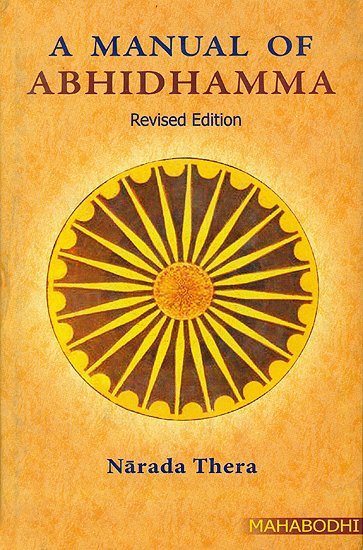A Manual of Abhidhamma
by Nārada Thera | 80,494 words | ISBN-13: 9789380336510
In the Abhidhammattha Sangaha there is a brief exposition of the Law of Dependent Origination, followed by a descriptive account of the Causal Relations that finds no parallel in any other philosophy. Edited in the original Pali Text with English Translation and Explanatory Notes by Narada Maha Thera....
§ 5.
- Sabbasangahe - Pañcakkhandho, rūpakkhandho, vedanākkhandho, saññākkhandho, sankhārakkhandho, viññānakkhandho.
- Pañcupādānakkhandhā - rūpupādānakkhandho, vedanūpādānakkhandho, saññūpādānakkhandho, sankhārūpādānakkhandho, viññānupādānakkhandho.
- Dvādasāyatanāni - cakkhāyatanam, sotāyatanam ghānāyatanam, jivhāyatanam, kāyāyatanam, manāyatanam, rūpāyatanam, saddāyatanam, gandhāyatanam, rasāyatanam, photthabbāyatanam, dhammāyatanam.
- Atthārasadhātuyo - cakkhudhātu, sotadhātu, ghānadhātu, jivhādhātu, kāyadhātu, rūpadhātu, saddadhātu, gandhadhātu, rasadhātu, photthabbadhātu cakkhuviññānadhātu, sotaviññānadhātu, ghānaviññānadhātu, jivhāviññānadhātu, kāyaviññānadhātu, manodhātu, dhammadhātu, manoviññānadhātu.
- Cattāri ariyasaccāni - dukkham ariyasaccam, dukkhasamudayo ariyasaccam, dukkhanirodho ariyasaccam, dukkhanirodhagāminipatipadā ariyasaccam.
Ettha pana cetasikā-sukhumarūpa-nibbānavasena ekūnasatti dhammā dhammāyatanadhammadhātū'ti sankham gacchanti. Manāyatanam eva sattaviññānadhātu vasena bhijjati.
1. Rupañ ca vedanā saññā sesā cetasikā tathā
Viññānam iti pañc'ete pañcakkhandhā'ti bhasitā.
2. Pañc' upādānanakkhandhā'ti tathā tebhumakā matā
Bhedābhāvena nibbānam khandhasangaha-nissatam.
3. Dvārālambanabhedena bhavantāyatanāni ca
Dvārālambataduppannapariyāyena dhātuyo
4. Dukkham tebhūmakam vattam tanhāsamudayo bhave
Nirodho nāma nibbānam maggo lokuttaro mato.
5. Maggayuttā phalā c'eva catusaccavinissatā
Iti pañcappabhedena pavutto sabbasangaho.
Iti Abhidhammatthasangahe samuccayasangahavibhāgo nāma sattamaparicchedo.
(translation) (36)
§ 5. In the compendium of 'the whole' there are:
-
The Five Aggregates (37):
- matter,
- feeling,
- perception,
- mental states (38),
- consciousness.
-
The Five Aggregates of Grasping (39):
- matter,
- feeling,
- perception,
- mental states,
- consciousness.
-
The Twelve Spheres (40):
-
Sense-Organs:
- eye (41),
- ear,
- nose,
- tongue,
- body,
- mind (42).
-
Sense-Objects
- visible object,
- sound,
- odour,
- taste,
- tangible object,
- cognizable object.
-
Sense-Organs:
-
The Eighteen Elements (43):
- eye,
- ear,
- nose,
- tongue,
- body,
- visible object,
- sound,
- odour,
- taste,
- tangible object,
- eye-consciousness,
- ear-consciousness,
- nose-consciousness,
- tongue-consciousness,
- body-consciousness,
- mind,
- cognizable object (44),
- mind-consciousness (45).
-
The Four Noble Truths (46):
- the Noble Truth of Suffering,
- the Noble Truth of the Cause of Suffering,
- the Noble Truth of the Cessation of Suffering,
- the Noble Truth of the Path leading to the Cessation of Suffering.
Herein sixty-nine entities comprising 52 mental states, 16 subtle matter, and Nibbāna, are regarded as the sphere of cognizables and the cognizable element. Only the sphere of mind divides itself into seven consciousness-elements.
Summary
Matter, feeling, perception, remaining mental states, and consciousness - these five are called the five Aggregates.
Similarly those that pertain to the three planes are regarded as Five Aggregates of grasping.
As Nibbāna lacks differentiation (such as past, present, future) it is excluded from the category of Aggregates.
Owing to the difference between doors and objects there arise (twelve) sense-spheres. In accordance with doors, objects, and their resultant consciousness arise the elements.
Existence in the three planes is suffering. Craving is its cause. Cessation is Nibbāna. Path is regarded as supramundane.
Mental states associated with the Paths and the Fruits are excluded from the four Truths.
Thus the category of 'the whole' has been explained in five ways.
This is the seventh chapter of the Compendium of Abhidhamma dealing with the Abhidhamma Categories.
Notes:
36. Category of all such as Aggregates, etc.
37. Khandha means group, mass, aggregate. The Buddha analyses the so-called being into five groups. All the past, present, and future material phenomena are collectively called rūpakkhandha. The other four divisions should be similarly understood.
38. Here the term Sankhāra is used in a specific sense. Of the 52 mental states, feeling is one, and perception is another. The remaining 50 mental states are collectively called sankhāra. Mental formations, propensities, tendencies, syntheses, do not exactly convey the meaning of the Pāli term. Even 'volitional activities' is not very appropriate.
'Mental states' is too general, but is not misleading.
39. Upādānakkhandha. They are so called because they form the objects of clinging or grasping. The eight supramundane states of consciousness and mental states found therein, and the ten material qualities not born of Kamma. are not treated as upādānakkhandha.
40. āyatana means a field, sphere, basis.
41.Cakkhāyatana means the sensitive part of the eye which responds to visual stimuli. The four remaining sense-organs should be similarly understood.
42. Manāyatana - There is no special organ for the mind like the physical organs. By mind-sphere is meant the 'adverting consciousness' (manodvārāvajjana) together with the preceding 'arrest bhavanga' (bhavangupaccheda). See Chapter 1.
43. Dhātu is that which bears its own characteristic.
44. Dhamma-dhātu is synonymous with dhammāyatana but differs from dhammārammana as it does not include citta (consciousness), paññatti (concepts), and pasāda-rūpas (sensitive material phenomena).
45. Manoviññānadhātu - Of the 89 classes of consciousness 76 types of consciousness are regarded as mind-consciousness, excluding the tenfold sense-consciousness (dvipañcaviññāna) and the three manodhātu (= two types of receiving-consciousness and sense-door consciousness).
46. Ariyasacca - The Pāli term for truth is sacca which means that which is. Its Sanskrit equivalent is satya which denotes an incontrovertible fact. The Buddha enunciates four such truths which are associated with so-called beings. They are called ariyasaccānī because they were discovered by the Greatest Ariya, the Buddha, who was far removed from passions .
The first truth deals with dukkha which, for need of a better English equivalent, is inappropriately rendered by suffering or sorrow. As a feeling dukkha means that which is difficult to endure. As an abstract truth dukkha is used in the sense of contemptible (du) emptiness (kha). The world rests on suffering - hence it is contemptible. It is devoid of any reality - hence it is empty or void. Dukkha, therefore, means contemptible void.
The cause of this suffering is craving or attachment (tanhā) which leads to repeated births. The third Noble Truth is Nibbāna which can be achieved in this life itself by the total eradication of all forms of craving. The fourth Truth is the Noble Eightfold Path or the Middle Way.
